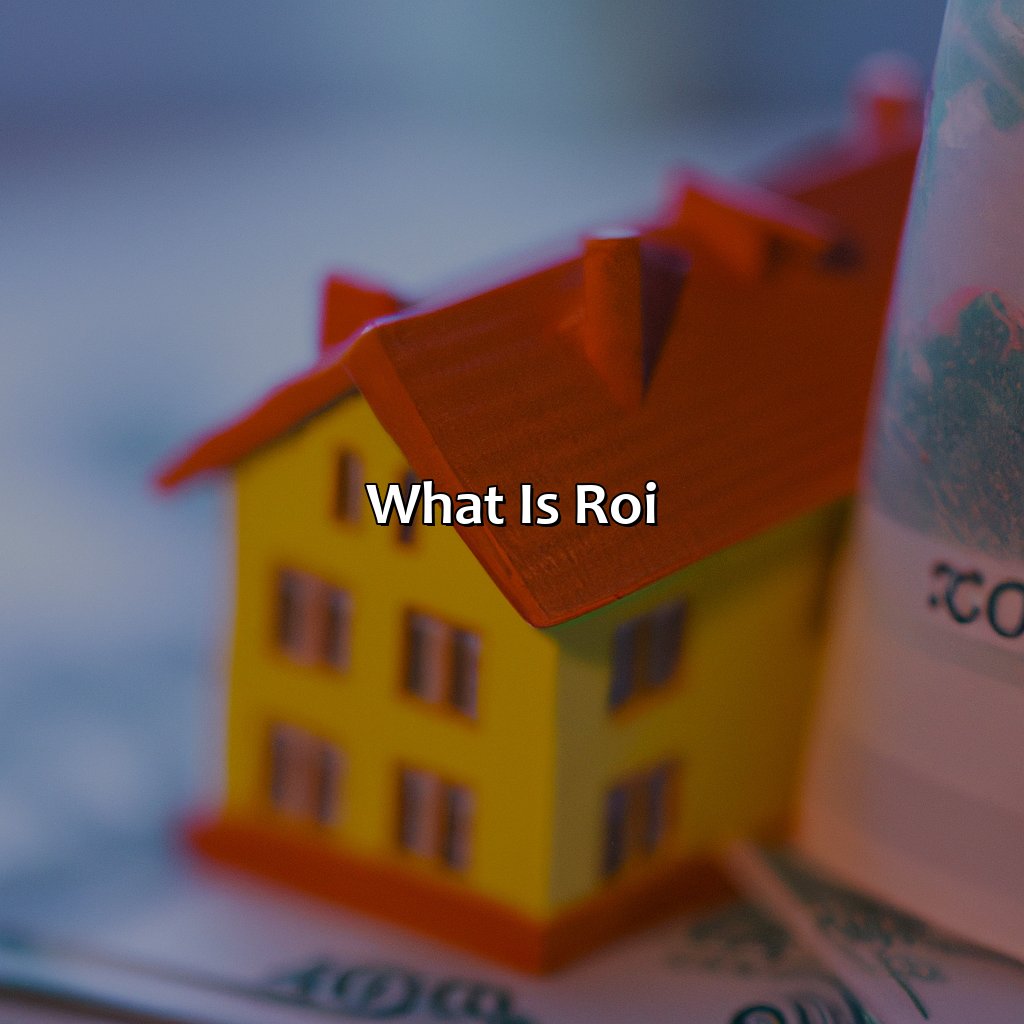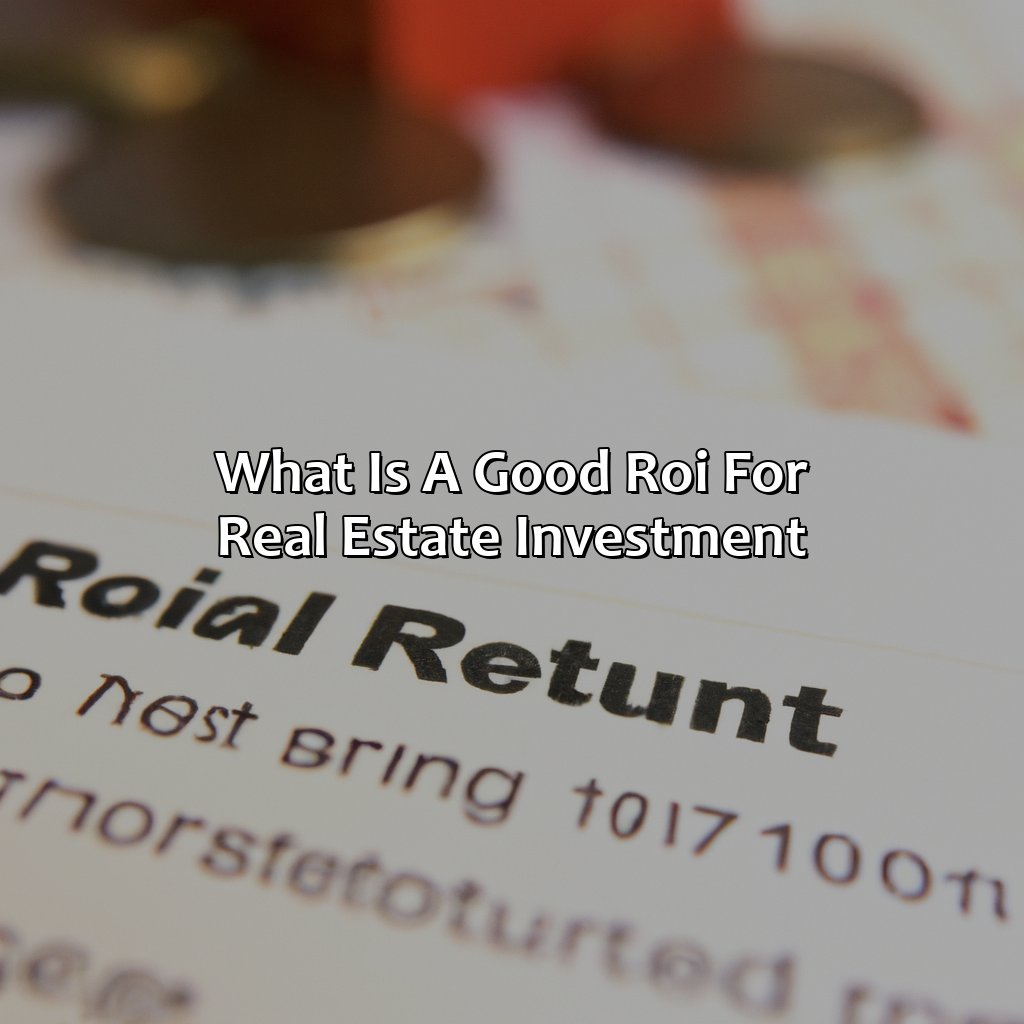What Is A Good Roi For Real Estate Investment?
Key takeaway:
- ROI (Return on Investment) refers to the profit or loss generated by an investment, expressed as a percentage of the initial investment amount.
- The factors that affect ROI in real estate investment include location, property type and condition, rental income, and expenses and taxes.
- A good ROI for real estate investment can depend on industry benchmarks, individual goals and circumstances, and calculated using the cap rate formula. Diversification is also important in ensuring a healthy real estate investment portfolio.
Are you looking for real estate investment opportunities, but don’t know how to identify a good return on investment (ROI)? In this blog, you’ll learn about the factors you should consider when investing in real estate, so you can make an informed decision.
What is ROI?
ROI, or return on investment, is a financial metric used to evaluate the profitability of an investment. It represents the percentage of the initial investment that has been earned back through profits. In other words, ROI measures the amount of money gained or lost on an investment relative to the amount of money invested.
Real estate investors use ROI to analyze the financial performance of their property investments, including rental income, expenses, and appreciation. A good ROI for a real estate investment varies depending on the location, type of property, and investor’s goals. Generally, an ROI of 10% or higher is considered good for a rental property investment, while flipping a property requires a higher ROI of 20% or more. However, investors should also consider other factors, such as market trends, vacancy rates, and potential repairs and maintenance costs, when calculating ROI.
It’s essential to note that ROI is not the only factor to consider when making real estate investment decisions. Investors should also look at the cash flow, potential tax benefits, and long-term appreciation of the property.
In a recent case study, a real estate investor purchased a rental property in a growing neighborhood for $200,000. They spent an additional $20,000 on renovations and repairs before renting the property out for $2,000 a month. After deducting expenses such as property taxes, insurance, and maintenance costs, the net annual rental income was about $15,000. The ROI for this investment would be approximately 7.5%, which is lower than the industry average. However, the investor also considered the potential for long-term appreciation in the neighborhood and felt confident that the property’s value would increase, making it a worthy investment.
Overall, ROI is an essential metric in real estate investing, but investors should also evaluate other factors to make well-informed investment decisions.

Image credits: retiregenz.com by Yuval Washington
Factors that affect ROI in real estate investment
Understand the ROI to see how various factors affect your real estate investment. Maximize returns by focusing on the location, property type and condition, rental income, expenses, and taxes. Each is vital in deciding the overall ROI.

Image credits: retiregenz.com by James Woodhock
Location
Choosing the Perfect Spot
When it comes to real estate investment, the perfect spot can make a significant difference. The location of your investment is crucial as it directly affects the ROI.
- Accessibility– Properties that have easy access to public transportation, highways and other amenities, see an increase in property value over time.
- Nearby Developments– Areas that are seeing new developments such as planned commercial areas or residential colonies, have a better chance of earning a good return on investment.
- Safety– A safe neighbourhood creates demand and interest amongst potential tenants or buyers. It is important to research crime statistics before choosing a property location.
Apart from these 3 vital factors, you should also consider aspects like demographics, schools and market trends while selecting your location.
Don’t miss out on lucrative investments due to poor location choices. Ensure any purchase is made with both your head and heart in line; use data analysis alongside intuition to find the perfect investment for maximum ROI.
Buying a fixer-upper may seem like a good idea, until you realize the only thing getting fixed up is your ROI.
Property type and condition
For real estate investment, the type and condition of the property being invested in are crucial factors affecting ROI. A wise investor knows that investing in a property with high maintenance costs can significantly reduce overall returns. Likewise, certain types of properties may have higher or lower ROI potential based on the current market trends.
To better understand this factor, let’s take a look at the following table:
| Property Type | Condition | Average ROI |
|---|---|---|
| Single-family homes | Newly Built | 8-10% |
| Rental properties | Fair Condition | 6-8% |
| *Data provided by Real Estate Investment Network (REIN) | ||
From the table above, we can see that newly built single-family homes offer a higher average ROI than fair-condition rental properties. This is because new homes require less maintenance and repair costs compared to older rental properties, which can eat up profits over time.
It’s worth noting that there are other factors such as location, occupancy rates, and rental income potential that must be considered when investing in real estate. However, property type and condition remain significant determinants of ROI.
One interesting detail about property type and condition is that they tend to be influenced by external factors like economic cycles and supply and demand forces in the housing market. Despite these challenges, successful investors can mitigate risk by performing thorough market research before making any investment decisions.
According to Forbes.com, “real estate investors must keep an eye on evolving market trends to stay ahead of the game.” Therefore, staying up-to-date with the latest industry news and market forecasts can help investors overcome challenges and optimize their returns.
“Rental income is like a box of chocolates, you never know what you’re going to get- unless you invest in a good property management company.”
Rental income
The rental yield is a crucial factor in real estate investment, and it helps determine the return on your investment. It reflects the annual rent you receive from your property as a percentage of its purchase price. A high rental yield indicates that the property generates higher income, while a low rental yield implies lower income.
To maximize your rental income, ensure that the property is in a desirable location with high demand and a low vacancy rate. Additionally, maintaining your property’s condition can help to increase the value and attract higher-paying tenants.
It’s important to note that rental income alone cannot predict ROI accurately. It’s also crucial to consider other factors such as operating expenses, financing costs, tax implications, and potential appreciation or depreciation in value.
To avoid missing out on opportunities for a good ROI, ensure you have conducted thorough research on all relevant factors before investing in real estate. Seek advice from professionals and stay up-to-date with market trends to make informed decisions and achieve financial success in real estate investment.
Real estate investment: Where the only thing certain are expenses and taxes, like death and taxes but without the sweet release of death.
Expenses and taxes
Real estate investment incurs various expenses and taxes that impact return on investment. For profitable real estate investments, minimizing expenses while maintaining property value is crucial.
Below is a table outlining common expenses and tax deductions for real estate investors:
| Expenses | Details |
|---|---|
| Property Management Fees | Monthly fees taken by property managers for managing the property |
| Property Insurance | Insurance premium paid to insulate losses related to the property |
| Property Taxes | Regular charges imposed by government authorities on the property owner |
| Maintenance Costs | Expenses incurred to maintain the physical condition of the property |
It is essential to factor in these expenses when calculating ROI on a real estate investment. Moreover, other miscellaneous costs like repair costs, vacancy costs, and utility charges should be included in calculations.
Investors can lower their tax burden through deductions like repairs and maintenance costs. Therefore, investors must prioritize proper record-keeping to keep track of all associated costs.
According to The Balance SMB, real estate taxes account for approximately 42% of total business expenses associated with rental properties in 2021.
Turns out, a good ROI in real estate is like finding a unicorn – elusive and magical, but totally worth the search.
What is a good ROI for real estate investment?
To get an understanding of a great ROI for real estate investment, you need to think about factors such as industry standards, personal ambitions and scenarios. You can figure out the ROI with the cap rate formula. Additionally, realize the need for diversification in a real estate investment portfolio.

Image credits: retiregenz.com by Harry Jones
Industry benchmarks
Looking at established measures in the real estate industry, we can gain insight into what good returns on investments look like. Examining data from successful investors, we can determine industry benchmarks for ROI percentages based on various investment types.
Below is a table outlining the current industry benchmarks for ROI in real estate investments. The data is based on actual returns gained from historical transactions across multiple investment categories.
| Investment Type | Average ROI |
|---|---|
| Single Family Rental Property | 6-10% |
| Commercial Property | 6-12% |
| Multi-Family Properties | 8-12% |
It’s important to note that these are not hard and fast rules but rather broad guidelines which can vary depending on market conditions as well as individual performance. Additionally, once investment goals are determined, an investor should consult with an experienced financial advisor for more targeted advice that accounts for their unique needs and goals.
Looking at past trends, rising population growth has provided a boost to real estate investments over the years. As a result, it remains one of the most sound and stable financial investments with excellent return rates and benefits when done right.
Investing in real estate is like dating – you have to know your goals and circumstances before committing to a long-term relationship.
Individual goals and circumstances
Your individual aspirations and circumstances play a crucial role in determining the ideal ROI for your real estate investment. A high ROI might be favorable for an investor seeking higher profits, but it can also lead to greater risks and extensive expenses based on personal capacity and external factors.
If your primary aim is consistent rental income flow, then a lower but stable ROI could be suitable for you. Additionally, analyzing the local market trends, property value appreciation over time and potential demands of the tenants are some of the critical considerations that influence your decision.
While identifying goals and assessing risks are essential components of any investment plan, planning according to individual financial situations is also paramount. Adhering to reasonable financing opportunities can lead to long-term financial stability.
Opting for renovation projects or low market sales prices could equate to good long-term investments that would yield high ROIs regardless of initial costs and expenses.
For instance, Tanya purchased her first apartment at $400k with hard work and strategic financial planning given the current economic climate projections. She remodeled her living space while renting out extra rooms on short-term rentals. Her returns doubled within two years due to increased demand making it a beneficial investment strategy in her case.
Calculating ROI with the cap rate formula: Because math is more than just a four-letter word.
Calculating ROI using the cap rate formula
Investors calculate the ROI of their real estate investments to determine profitability. One method is to use the cap rate formula.
To calculate ROI using the cap rate formula, follow these three steps:
- Determine your property’s net operating income.
- Divide net operating income by the property’s value or purchase price to get its cap rate.
- Subtract your annual loan payments from your net operating income and divide that number by your down payment and closing costs.
While this method may be straightforward, it does not account for fluctuations in market values which may affect future earnings. Investors must also consider other factors such as taxes, insurance, vacancy, and maintenance costs.
One suggestion for maximizing ROI is selecting properties in desirable locations with strong potential for appreciation. Another is conducting thorough research and due diligence before making a purchase, including inspecting properties for potential issues that may impact long-term profitability. Ultimately, successful real estate investing requires a balanced portfolio and a diligent approach to maintaining properties over time.
Importance of diversification in real estate investment portfolio
Diversifying your real estate investment portfolio is essential to mitigate potential risks and increase profitability. Having a mixed real estate asset portfolio with different classes of properties – commercial, residential, retail space, and industrial properties – can balance out the risk of market fluctuations. Such diversification ensures that you don’t have all eggs in one basket and helps in weathering economic downturns. Furthermore, such multi-real estate assets also act as an excellent hedge against inflation. Diversification is significant for any investor who wants to get the maximum returns on investment while minimizing exposure to risk.
Investors should pay particular attention to location, tenant mix, and property types while creating a diversified portfolio. Purchasing properties in various states or countries can spread risks over several markets instead of being tied up in only one market; this helps minimize potential losses that could arise if the law suddenly changes, or new developments emerge. Furthermore, by having properties in different locations, investors can cater to a broader range of clients by offering competitive prices that suit individual needs.
The advantages of investing in diversified real estate portfolios outweigh the disadvantages substantially since this strategy allows one room for growth while fighting off competition within different property classes; managing and maximizing returns would not look like such a herculean task anymore. By retargeting funds for growth through diversification techniques, investors can boost profits significantly over time.
Diversifying your real estate portfolio guarantees maximum security with minimal damage possible when unforeseen events occur. While it might involve extra work upfront due to research or expertise costs required before allocating funds into diverse asset classes, every successful business inclines towards safeguarding their financial future using these strategies as they ensure increased probability rate towards good Return On Investments (ROI) incrementals over time – which is ultimately every investor’s goal!
Five Facts About What Is a Good ROI for Real Estate Investment:
- ✅ A good ROI for real estate investment is generally considered to be at least 10%. (Source: FortuneBuilders)
- ✅ Real estate investors should take into account factors such as cash flow, appreciation, and tax benefits when determining ROI. (Source: BiggerPockets)
- ✅ A higher ROI does not necessarily mean a better investment, as it may come with higher risk or require more effort to manage. (Source: Mashvisor)
- ✅ Real estate investors can use tools such as cap rate and cash-on-cash return to calculate ROI. (Source: Forbes)
- ✅ A good ROI can vary depending on the location, type of property, and overall market conditions. (Source: Investopedia)
FAQs about What Is A Good Roi For Real Estate Investment?
What is a good ROI for real estate investment?
A good ROI for real estate investment varies depending on location, market trends, and individual goals. However, a general guideline is to aim for a minimum of 10% ROI.
What factors affect ROI in real estate investment?
Several factors can affect ROI in real estate investment, including property location, market trends, property condition, rental income, and expenses related to maintenance and repairs.
How can I calculate ROI for a real estate investment?
You can calculate ROI for a real estate investment by subtracting the total expenses from the total income generated and dividing the result by the total investment. Multiply this figure by 100 to get the percentage ROI.
What are some strategies to increase ROI in real estate investment?
Some strategies to increase ROI in real estate investment include investing in up-and-coming neighborhoods, making strategic renovations to increase property value, and maximizing rental income by finding reliable tenants and adjusting rental rates according to market trends.
Is a high ROI always better in real estate investment?
Not necessarily. A high ROI may indicate a riskier investment that requires more maintenance or management. It’s important to balance ROI with other factors, such as location and property condition, to make a well-informed investment decision.
What are the risks associated with real estate investment?
Real estate investment carries risks, including market fluctuations, vacancy rates, and unexpected maintenance or repair costs. It’s important to conduct thorough research and speak with a professional before making any investment decisions.


